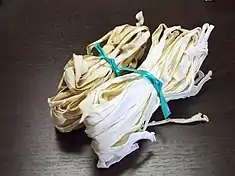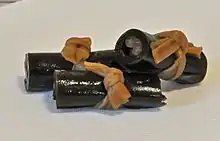Kanpyō (food)
Kanpyō (かんぴょう or 干瓢), sometimes romanized and pronounced kampyō, are dried shavings of Lagenaria siceraria var. hispida, a variety of calabash gourd. The gourd is known as yugao or fukube in Japanese.[1] Kanpyō is an ingredient in traditional Edo style Japanese cuisine. Cooked and flavored kanpyō is commonly used in futomaki sushi roll.[1]
 Kanpyō (raw), dried shavings of Lagenaria siceraria var. hispida | |
| Nutritional value per 100 g | |
|---|---|
| Energy | 1,079 kJ (258 kcal) |
65.03 g | |
| Dietary fiber | 9.8 g |
0.56 g | |
| Saturated | 0.045 g |
| Trans | 0 |
| Monounsaturated | 0.103 g |
| Polyunsaturated | 0.244 g |
8.58 g | |
| Vitamins | Quantity %DV† |
| Vitamin A | 0 IU |
| Thiamine (B1) | 0% 0 mg |
| Riboflavin (B2) | 4% 0.044 mg |
| Niacin (B3) | 19% 2.9 mg |
| Pantothenic acid (B5) | 51% 2.553 mg |
| Vitamin B6 | 41% 0.532 mg |
| Folate (B9) | 15% 61 μg |
| Vitamin B12 | 0% 0 μg |
| Vitamin C | 0% 0.2 mg |
| Vitamin D | 0% 0 IU |
| Minerals | Quantity %DV† |
| Calcium | 28% 280 mg |
| Copper | 22% 0.433 mg |
| Iron | 39% 5.12 mg |
| Magnesium | 35% 125 mg |
| Manganese | 54% 1.137 mg |
| Phosphorus | 27% 188 mg |
| Potassium | 34% 1582 mg |
| Selenium | 4% 2.6 μg |
| Sodium | 1% 15 mg |
| Zinc | 62% 5.86 mg |
| Other constituents | Quantity |
| Water | 19.97 g |
| Alcohol (ethanol) | 0 |
| Caffeine | 0 |
| Cholesterol | 0 |
| |
| †Percentages are roughly approximated using US recommendations for adults. Source: USDA FoodData Central | |
Kanpyō was originally grown in the Osaka region. Now it is a specialty product of Tochigi Prefecture,[2] where it is a cottage industry.[1] The region is so tied to the food product that it hosts the "Kanpyō Highway with History and Romance".[3] The yuru-chara for Oyama, Tochigi is Kapyomaru (かぴょ丸), an anthropomorphized calabash.[3]
The gourd is harvested between late July and September. The white flesh of the gourd is cut into strips 3 cm wide and 3 mm thick, then either dried in the sun or dehydrated.[4] Over 200 tons a year of dried kanpyō are produced per year.[1] Kanpyō available in the United States is sometimes chemically bleach-dried to a very white color, as opposed to the creamy color of the naturally-dried kind.[2] Sulfur dioxide is used sometimes used as a fumigant but must not be used in concentrations exceeding 5.0 g per 1 kg of dry matter.[5]
Dishes featuring kanpyō

In addition to being the focus of many dishes, kanpyō strips are frequently used as an edible twist tie in dishes such as fukusa-zushi and chakin-zushi.[1] Typically the dried strips are boiled to soften, and then boiled a second time with soy sauce, sugar, and other ingredients added for flavor.[1][6]
.jpg.webp)
- Futomaki[1][6]
- Kanpyō-maki, also called teppo maki ("gun barrel maki") as it looks like the end of a rifle[1]
- Matsukasa sushi ("pinecone sushi"), a roll using squid filet (instead of nori) wrapped around sushi rice, kanpyō, shiitake, snow peas, and whitefish[1]
- Shojin dashijiru, a vegan soup stock[2]

See also
References
- Lowry, Dave (2005). The Connoisseur's Guide to Sushi: Everything You Need to Know about Sushi Varieties and Accompaniments, Etiquette and Dining Tips, and More. Harvard Common Press. ISBN 9781558323070. OCLC 962114405. Retrieved 3 July 2019.
- Homma, Gaku (1991). The Folk Art of Japanese Country Cooking: A Traditional Diet for Today's World. Translated by Busch, Emily. North Atlantic Books. pp. 80–81. ISBN 9781556430985. OCLC 22623869.
- "祝!「歴史とロマンのかんぴょう街道」開通" [Congratulation! "History and romance Kanpyō Highway" opened] (html). Mibu Town Tochigi (in Japanese). 321-0292 栃木県下都賀郡壬生町通町12番22号. 2 March 2011. Retrieved 8 July 2019.CS1 maint: location (link)
- "かんぴょう" [Kanpyō]. Nihon Daihyakka Zensho (Nipponika) (in Japanese). Tokyo: Shogakukan. 2012. OCLC 153301537. Archived from the original on 2007-08-25. Retrieved 2012-06-07.
- "食品添加物の指定、使用基準の改正等について" [About designation of food additive, revision of use standard] (html). 厚生労働省 (in Japanese). 20 January 2004. Retrieved 3 July 2019.
- Kawasumi, Ken (2001). The Encyclopedia of Sushi Rolls. Translated by Driussi, Laura. Japan Publications Trading. ISBN 9784889960761. OCLC 921930235. Retrieved 3 July 2019.